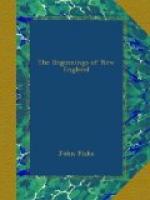In Massachusetts after 1650 the opinion rapidly gained ground that all baptized persons of upright and decorous lives ought to be considered, for practical purposes, as members of the church, and therefore entitled to the exercise of political rights, even though unqualified for participation in the Lord’s Supper. This theory of church-membership, based on what was at that time stigmatized as the “Halfway Covenant,” aroused intense opposition. It was the great question of the day. In 1657 a council was held in Boston, which approved the principle of the Halfway Covenant; and as this decision was far from satisfying the churches, a synod of all the clergymen in Massachusetts was held five years later, to reconsider the great question. The decision of the synod substantially confirmed the decision of the council, but there were some dissenting voices. Foremost among the dissenters, who wished to retain the old theocratic regime in all its strictness, was Charles Chauncey, the president of Harvard College, and Increase Mather agreed with him at the time, though he afterward saw reason to change his opinion, and published two tracts in favour of the Halfway Covenant. Most bitter of all toward the new theory of church-membership was, naturally enough, Mr. Davenport of New Haven. [Sidenote: The “Halfway Covenant”]
This burning question was the source of angry contentions in the First Church of Boston. Its teacher, the learned and melancholy Norton, died in 1663, and four years later the aged pastor, John Wilson, followed him. In choosing a successor to Wilson the church decided to declare itself in opposition to the liberal decision of the synod, and in token thereof invited Davenport to come from New Haven to take charge of it. Davenport, who was then seventy years old, was disgusted at the recent annexation of his colony to Connecticut. He accepted the invitation and came to Boston, against the wishes of nearly half of the Boston congregation who did not like the illiberal principle which he represented. In little more than a year his ministry at Boston was ended by death; but the opposition to his call had already proceeded so far that a secession from the old church had become inevitable. In 1669 the advocates of the Halfway Covenant organized themselves into a new society under the title of the “Third Church in Boston.” A wooden meeting-house was built on a lot which had once belonged to the late governor Winthrop, in what was then the south part of the town, so that the society and its meeting-house became known as the South Church; and after a new church founded in Summer Street in 1717 took the name of the New South, the church of 1669 came to be further distinguished as the Old South. As this church represented a liberal idea which was growing in favour with the people, it soon became the most flourishing church in America. After sixty years its numbers had increased so that the old meeting-house could not contain them; and in 1729 the famous building which still stands was erected on the same spot,—a building with a grander history than any other on the American continent, unless it be that other plain brick building in Philadelphia where the Declaration of Independence was adopted and the Federal Constitution framed. [Sidenote: Founding of the Old South Church, 1669]




